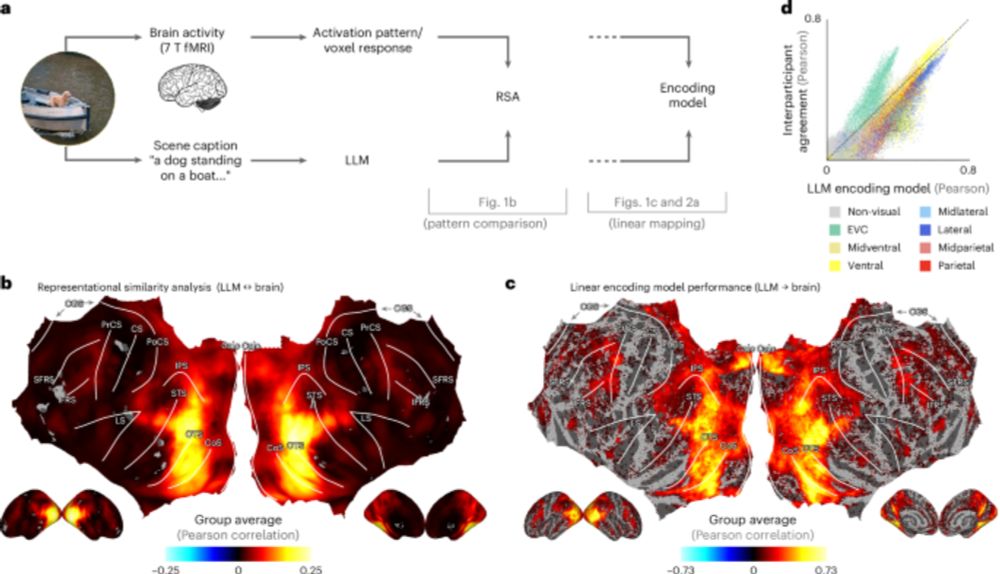
1/ How does deep sleep reshape our memories? Our new study shows that slow-wave sleep (SWS) reorganises episodic memory networks, shifting recall from the parietal cortex to the anterior temporal lobe (ATL). With Polina Perzich and @bstaresina.bsky.social . A thread below👇
authors.elsevier.com/sd/article/S...

We asked a simple-but-big question:
What changes in the brain when someone becomes an expert?
Using chess ♟️ + fMRI 🧠 + representational geometry & dimensionality 📈, we ask:
1️⃣ WHAT information is encoded?
2️⃣ HOW is it structured?
3️⃣ WHERE is it expressed?
1/n

We asked a simple-but-big question:
What changes in the brain when someone becomes an expert?
Using chess ♟️ + fMRI 🧠 + representational geometry & dimensionality 📈, we ask:
1️⃣ WHAT information is encoded?
2️⃣ HOW is it structured?
3️⃣ WHERE is it expressed?
1/n
The method generates descriptive text of what we perceive and recall from brain activity — a linguistic interpretation of nonverbal mental content rather than language decoding.
doi.org/10.1126/scia...

The method generates descriptive text of what we perceive and recall from brain activity — a linguistic interpretation of nonverbal mental content rather than language decoding.
doi.org/10.1126/scia...
📧 DM me or check out #PhD program www.unlv.edu/degree/phd-n... & www.unlv.edu/psychology/g...
Plus, Vegas is a fun place to live!🤟
📧 DM me or check out #PhD program www.unlv.edu/degree/phd-n... & www.unlv.edu/psychology/g...
Plus, Vegas is a fun place to live!🤟
A neural state space for episodic memories
www.sciencedirect.com/science/arti...
#neuroskyence #psychscisky #cognition 🧪

A neural state space for episodic memories
www.sciencedirect.com/science/arti...
#neuroskyence #psychscisky #cognition 🧪
tl;dr: you can now chat with a brain scan 🧠💬
1/n

tl;dr: you can now chat with a brain scan 🧠💬
1/n
The effect presumably comes from the absence of S-cones in the fovea.
From Hinnerk Schulz-Hildebrandt:
arxiv.org/pdf/2509.115...

The effect presumably comes from the absence of S-cones in the fovea.
From Hinnerk Schulz-Hildebrandt:
arxiv.org/pdf/2509.115...
1/8: How do human neurons encode meaning?
In this work, led by Katharina Karkowski, we recorded hundreds of human MTL neurons to study semantic coding in the human brain:
doi.org/10.1101/2025...

1/8: How do human neurons encode meaning?
In this work, led by Katharina Karkowski, we recorded hundreds of human MTL neurons to study semantic coding in the human brain:
doi.org/10.1101/2025...
#Decoding studies often rely on training in one (visual) condition and applying it to another (e.g. rest-reactivation). However: How well does this work? Show us what makes it work and win up to 1000$!
#Decoding studies often rely on training in one (visual) condition and applying it to another (e.g. rest-reactivation). However: How well does this work? Show us what makes it work and win up to 1000$!

I argued that our overly specialized, modular approach to studying the brain has given us a simplistic view of readout.
🧠📈
#neuroskyence
www.thetransmitter.org/the-big-pict...

I argued that our overly specialized, modular approach to studying the brain has given us a simplistic view of readout.
🧠📈
Different representational formats of a memory can be used at different times or in different contexts, and draw on different neural representations.
doi.org/10.31234/osf...
Different representational formats of a memory can be used at different times or in different contexts, and draw on different neural representations.
doi.org/10.31234/osf...
We trace the path from early brain decoding to modern NeuroAI, highlight progress & pitfalls, and discuss future directions www.annualreviews.org/content/jour...
We trace the path from early brain decoding to modern NeuroAI, highlight progress & pitfalls, and discuss future directions www.annualreviews.org/content/jour...

We built an RNN🤖 with key-value episodic memory that learns causal relationships between events and retrieves memories like humans do!
Preprint www.biorxiv.org/content/10.1...
w/ @qlu.bsky.social, Tan Nguyen &👇

We built an RNN🤖 with key-value episodic memory that learns causal relationships between events and retrieves memories like humans do!
Preprint www.biorxiv.org/content/10.1...
w/ @qlu.bsky.social, Tan Nguyen &👇
www.biorxiv.org/content/10.1...

www.biorxiv.org/content/10.1...
Great new review by Fenerci & @signysheldon.bsky.social in @cp-trendscognsci.bsky.social!
www.cell.com/trends/cogni...

Great new review by Fenerci & @signysheldon.bsky.social in @cp-trendscognsci.bsky.social!
www.cell.com/trends/cogni...
"Visual representations in the human brain are aligned with large language models"
🔗 www.nature.com/articles/s42...

"Visual representations in the human brain are aligned with large language models"
🔗 www.nature.com/articles/s42...
Excited to share our latest work on alpha/beta activity, eye movements, and memory.
Across 4 experiments combining scalp EEG/iEEG with eye tracking, we show that alpha/beta activity directly reflects eye movements, and only indirectly relates to memory.
👇 Highlights (1/7):
Excited to share our latest work on alpha/beta activity, eye movements, and memory.
Across 4 experiments combining scalp EEG/iEEG with eye tracking, we show that alpha/beta activity directly reflects eye movements, and only indirectly relates to memory.
👇 Highlights (1/7):

authors.elsevier.com/a/1lV174sIRv...
Here’s a quick 🧵(1/n)
authors.elsevier.com/a/1lV174sIRv...
Here’s a quick 🧵(1/n)
“Top-down and bottom-up neuroscience: overcoming the clash of research cultures”
www.nature.com/articles/s41...
Looking for ways to better understand different neuroscientific perspectives and enable productive collaborations

“Top-down and bottom-up neuroscience: overcoming the clash of research cultures”
www.nature.com/articles/s41...
Looking for ways to better understand different neuroscientific perspectives and enable productive collaborations

